四年级英语上册第四单元unit4(5课时)
- 格式:pptx
- 大小:26.43 MB
- 文档页数:26
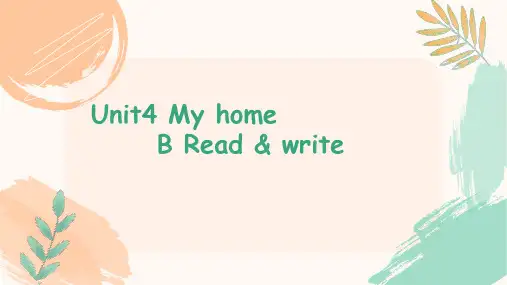
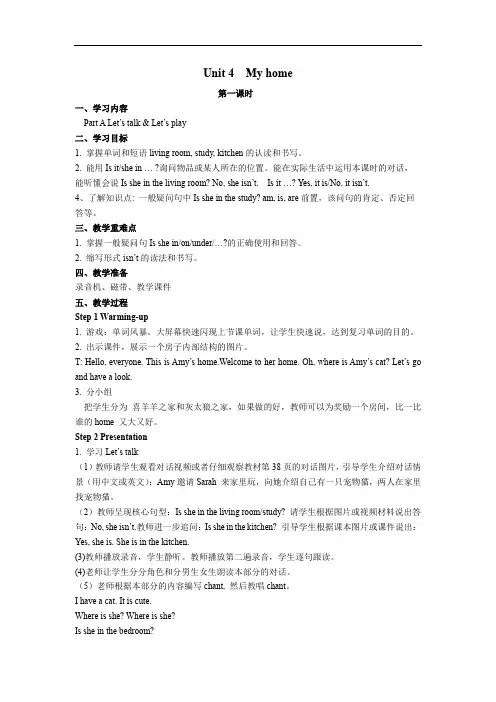
Unit 4 My home第一课时一、学习内容Part A Let’s talk & Let’s play二、学习目标1. 掌握单词和短语living room, study, kitchen的认读和书写。
2. 能用Is it/she in … ?询问物品或某人所在的位置。
能在实际生活中运用本课时的对话,能听懂会说Is she in the living room? No, she isn’t. Is it …? Yes, it is/No, it isn’t.4、了解知识点: 一般疑问句中Is she in the study? am, is, are前置,该问句的肯定、否定回答等。
三、教学重难点1. 掌握一般疑问句Is she in/on/under/…?的正确使用和回答。
2. 缩写形式isn’t的读法和书写。
四、教学准备录音机、磁带、教学课件五、教学过程Step 1 Warming-up1. 游戏:单词风暴。
大屏幕快速闪现上节课单词,让学生快速说,达到复习单词的目的。
2. 出示课件,展示一个房子内部结构的图片。
T: Hello, everyone. This is Amy’s home.Welcome to her home. Oh, where is Amy’s cat? Let’s go and have a look.3. 分小组把学生分为喜羊羊之家和灰太狼之家,如果做的好,教师可以为奖励一个房间,比一比谁的home 又大又好。
Step 2 Presentation1. 学习Let’s talk(1)教师请学生观看对话视频或者仔细观察教材第38页的对话图片,引导学生介绍对话情景(用中文或英文):Amy邀请Sarah 来家里玩,向她介绍自己有一只宠物猫,两人在家里找宠物猫。
(2)教师呈现核心句型:Is she in the living room/study? 请学生根据图片或视频材料说出答句:No, she isn’t.教师进一步追问:Is she in the kitchen? 引导学生根据课本图片或课件说出:Yes, she is. She is in the kitchen.(3)教师播放录音,学生静听。
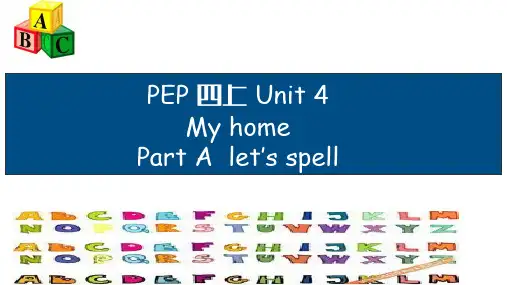
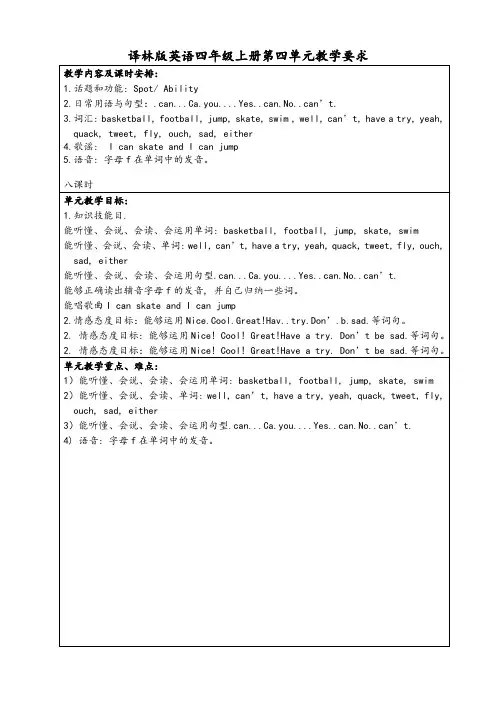
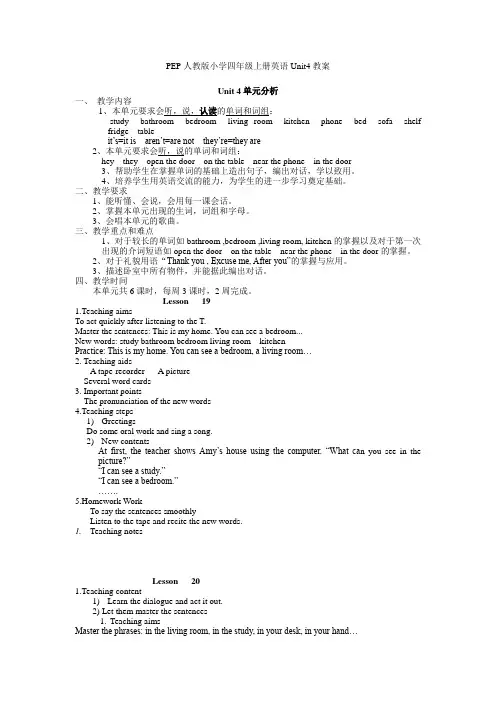
PEP人教版小学四年级上册英语Unit4教案Unit 4单元分析一、教学内容1、本单元要求会听,说,认读的单词和词组:study bathroom bedroom living room kitchen phone bed sofa shelf fridge tableit’s=it is aren’t=are not they’re=they are2、本单元要求会听,说的单词和词组:hey they open the door on the table near the phone in the door3、帮助学生在掌握单词的基础上造出句子,编出对话,学以致用。
4、培养学生用英语交流的能力,为学生的进一步学习奠定基础。
二、教学要求1、能听懂、会说,会用每一课会话。
2、掌握本单元出现的生词,词组和字母。
3、会唱本单元的歌曲。
三、教学重点和难点1、对于较长的单词如bathroom ,bedroom ,living room, kitchen的掌握以及对于第一次出现的介词短语如open the door on the table near the phone in the door的掌握。
2、对于礼貌用语“Thank you , Excuse me, After you”的掌握与应用。
3、描述卧室中所有物件,并能据此编出对话。
四、教学时间本单元共6课时,每周3课时,2周完成。
Lesson 191.Teaching aimsTo act quickly after listening to the T.Master the sentences: This is my home. Y ou can see a bedroom...New words: study bathroom bedroom living room kitchenPractice: This is my home. Y ou can see a bedroom, a living room…2. Teaching aidsA tape-recorder A pictureSeveral word cards3. Important pointsThe pronunciation of the new words4.Teaching steps1)GreetingsDo some oral work and sing a song.2)New contentsAt first, the teacher shows Amy’s house using the computer. “What ca n you see in the picture?”“I can see a study.”“I can see a bedroom.”…….5.Homework WorkTo say the sentences smoothlyListen to the tape and recite the new words.1.Teaching notesLesson 201.Teaching content1)Learn the dialogue and act it out.2) Let them master the sentences1.Teaching aimsMaster the phrases: in the living room, in the study, in your desk, in your hand…Use the dialogue smoothly.3. Important pointsThe pronunciation of the new words4.Teaching aidsA tape-recorder A pictureSeveral word cards5.Teaching steps1.GreetingSing an English song. Ask the students to introduce their homes.2.RevisionLearn the drills and practice the drills.T: What’s this? Ss: An eraser.T: yes, what does it like? S: It looks like a fish.T: Where is my eraser? Is she in the…?Ss: Y es, she is.(No, she isn’t.)Show them several pictures.T: Oh, how beautiful! Where is it?S: This is my bedroom.(This is myLiving-room. This is my bathroom.)T: Is this your ..? S: Y es, it is.(No, is n’t.)Game.-Where is my pen? -Is it in the …?- No, isn’t. - Is it in the …?-Y es, it is.Tell them the difference between “Is it…?” and “Is she…?”Listen to the tape and imitate. Practice in groups and act it out.6.HomeworkTo say the sentences smoothlyRecite the dialogue and listen to tape.2.Teaching notesLesson 211.Teaching AimsLet them master the words :home room school classroom(listening speaking reading and writing)And the sentencesWelcome to my ……home ……This is my ……room ……When they see the pictures, they can recognize and say their English names..2.Teaching Aidsa tape recorder cards pictures3.Important points4-skill words:home room school classroom4.Teaching steps1).Greeting and organizationSing an English song and do oral work.2). RevisionA:Act the dialogue of lesson 21B: Review these words:Home room school classroom3).PresentationRead the words and spell them.Ask a student come to the front to read all the words, and the others after him or her. 4).PracticeListen to the tape, imitate and practice the sentences.Read and spell the words.5. HomeworkSpell the words , then write them:Home room school classroom1.Teaching notesLesson 221.Teaching AimsLet the students master the words and phrase :phone bed shelf fridge table sofaLet the students listen and read these drill:Sit on … Make …Watch TV. Answer… Open… Set…2.Teaching Aidsa tape recorder cards pictures3.Important pointsLearn to say the words: phone shelf fridge table sofaWhen they see the subject, they can recognize and say their English names..4.Teaching steps1).Greeting and organizationSing a song and do a oral work.2). RevisionReview these words:Home room school classroom3).PresentationThe teacher shows the phone of the room and points at something one by one, and the students say it in English. In this way, learn to say the new words:phone shelf fridge table bed sofaAsk a student come to the front to read all the words, and the others read after him.4).Play a game:Passing the eight words between eight groups, and then checking which group did quickly and right.5).PracticeListen to the tape, imitate and practice the words:phone…Read and spell the words.6).Let’s doSit on the sofa. Make the bed. Watch TV. Answer the phone. Open the fridge. Set the table. 5.Homework1. Listen and read the new words and drill.2. Recite “Let’s do”.2.Teaching NotesLesson 231.Teaching content1) DrillsA: Are they on the …? A: Are they near…?B: Y es, they are. (No, they aren’t.)2)Learn the dialogue and act it out .3).Let’s chant.2. Teaching aimsLet them master the short sentences:Open the door on the table near the phoneLearn the new drills.Use the dialogue smoothly.3.important points1).The pronunciation of the new words2). A: Are they on the …? B: Y es, they are.(No, the arearen’t)4.Teaching aidsA tape-recorder A pictureSeveral word cards5.Teaching steps1).Greeting and organizationSing an English song and do oral work. Ask the students to introduce their home.2).At first, the teacher talk to the students.T: Where are the key(book…)?S: It’s on the table(in the desk, near the phone…)T: Where are the keys(books…)?S: They are on the table(in the desk, near the phone…)T: Are they on the table? S: Y es, they are.(No, they aren’t.)Then learn to say the drills. And practise the drill with the Ss. From “the T ask s, theS answers” to “the S asks, the S answers.”3) Then practise these drills smoothly.Play a game.S1:Where are the keys? S2:Are they in he …?S3: No, they aren’t. S2: Are they in the …?S3: Yes, they are.Tell them the different of “Is it…?” or“Are they…?”Listen to the recorder and imitate.Work in groups and act it out.6. HomeworkRecite the dialogue.To say the sentences smoothly3.Teaching notesLesson 241 .Teaching Aims1)Let the students master the four-skill words :Window desk door chair bed2)Let the students read these sentences:What can you see in my room? I can see…When they see the objects, they can recognize and read them and do the action about them.2 .Teaching Aidsa tape recorder.3.Difficult words and emphasis:4-skill letters and words:Window desk door chair bed4.Teaching steps1)OrganizationChant together and do a oral work.2). RevisionSpell the word: Window desk door chair bedPhrase: w_nd_w d_ _r d_sk ch___b_d3).PresentationWhen the teacher point at the subject, the students say the word and spell it. Then write these words.Read the drills smoothly:What can you see in my room?I can see…Read and choose: Listen to the T and choose A,B,C or4).Listen to the tape, imitate and read..5).GameThe teacher asks a student come to the front of the class, and tell him/her a word, then asks other students guess the word.5.HomeworkSpell and write the four-skill words :。
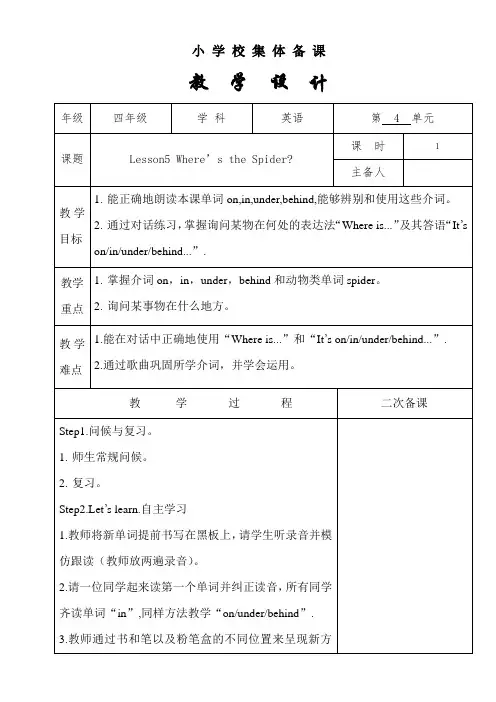
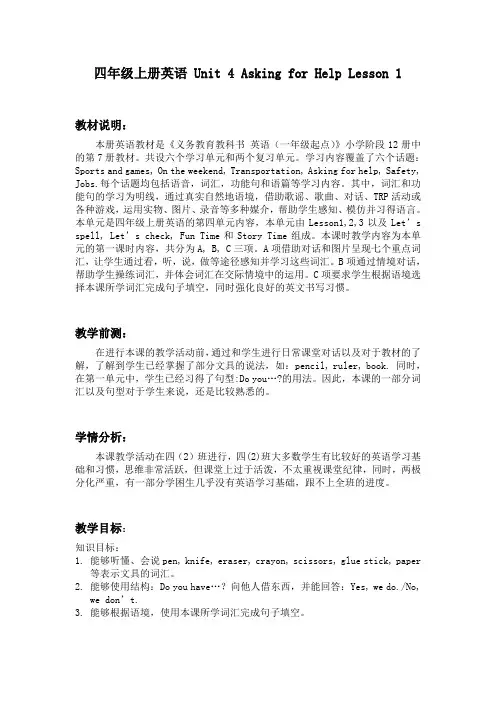
四年级上册英语 Unit 4 Asking for Help Lesson 1教材说明:本册英语教材是《义务教育教科书英语(一年级起点)》小学阶段12册中的第7册教材。
共设六个学习单元和两个复习单元。
学习内容覆盖了六个话题:Sports and games, On the weekend, Transportation, Asking for help, Safety, Jobs.每个话题均包括语音,词汇,功能句和语篇等学习内容。
其中,词汇和功能句的学习为明线,通过真实自然地语境,借助歌谣、歌曲、对话、TRP活动或各种游戏,运用实物、图片、录音等多种媒介,帮助学生感知、模仿并习得语言。
本单元是四年级上册英语的第四单元内容,本单元由Lesson1,2,3以及Let’s spell, Let’s check, Fun Time和Story Time组成。
本课时教学内容为本单元的第一课时内容,共分为A, B, C三项。
A项借助对话和图片呈现七个重点词汇,让学生通过看,听,说,做等途径感知并学习这些词汇。
B项通过情境对话,帮助学生操练词汇,并体会词汇在交际情境中的运用。
C项要求学生根据语境选择本课所学词汇完成句子填空,同时强化良好的英文书写习惯。
教学前测:在进行本课的教学活动前,通过和学生进行日常课堂对话以及对于教材的了解,了解到学生已经掌握了部分文具的说法,如:pencil, ruler, book. 同时,在第一单元中,学生已经习得了句型:Do you…?的用法。
因此,本课的一部分词汇以及句型对于学生来说,还是比较熟悉的。
学情分析:本课教学活动在四(2)班进行,四(2)班大多数学生有比较好的英语学习基础和习惯,思维非常活跃,但课堂上过于活泼,不太重视课堂纪律,同时,两极分化严重,有一部分学困生几乎没有英语学习基础,跟不上全班的进度。
教学目标:知识目标:1.能够听懂、会说pen, knife, eraser, crayon, scissors, glue stick, paper等表示文具的词汇。
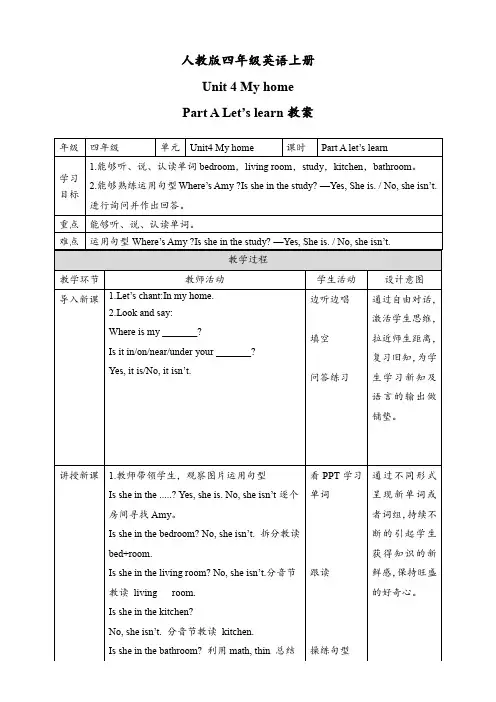
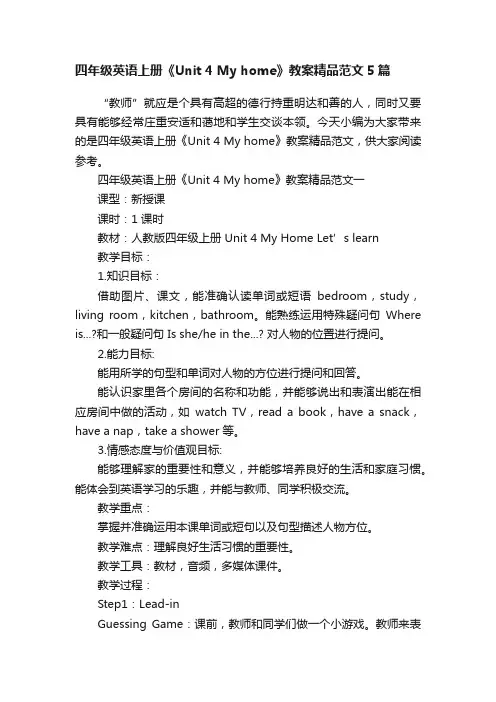
四年级英语上册《Unit 4 My home》教案精品范文5篇“教师”就应是个具有高超的德行持重明达和善的人,同时又要具有能够经常庄重安适和蔼地和学生交谈本领。
今天小编为大家带来的是四年级英语上册《Unit 4 My home》教案精品范文,供大家阅读参考。
四年级英语上册《Unit 4 My home》教案精品范文一课型:新授课课时:1 课时教材:人教版四年级上册Unit 4 My Home Let’s learn教学目标:1.知识目标:借助图片、课文,能准确认读单词或短语bedroom,study,living room,kitchen,bathroom。
能熟练运用特殊疑问句Where is...?和一般疑问句 Is she/he in the...? 对人物的位置进行提问。
2.能力目标:能用所学的句型和单词对人物的方位进行提问和回答。
能认识家里各个房间的名称和功能,并能够说出和表演出能在相应房间中做的活动,如watch TV,read a book,have a snack,have a nap,take a shower 等。
3.情感态度与价值观目标:能够理解家的重要性和意义,并能够培养良好的生活和家庭习惯。
能体会到英语学习的乐趣,并能与教师、同学积极交流。
教学重点:掌握并准确运用本课单词或短句以及句型描述人物方位。
教学难点:理解良好生活习惯的重要性。
教学工具:教材,音频,多媒体课件。
教学过程:Step1:Lead-inGuessing Game:课前,教师和同学们做一个小游戏。
教师来表演动作,学生一起猜。
教师分别表演动作 watch TV,read a book,have a snack,have a nap,take a shower,学生用英文答出相应的动作。
教师注意奖励答得又快又准确的同学。
游戏过后,教师提问学生可以在哪里做这些活动呢?“Where can we watch TV/ read a book/ have a snack...? ”由此引出 My Home 的主题。
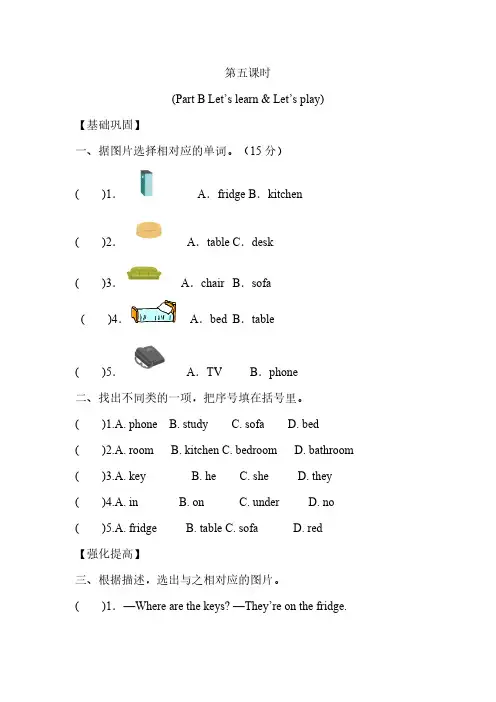
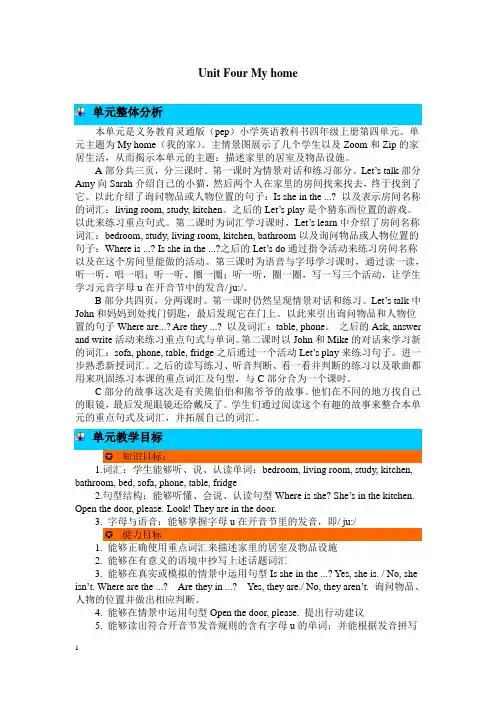
Unit Four My home单元整体分析本单元是义务教育灵通版(pep)小学英语教科书四年级上册第四单元。
单元主题为My home(我的家)。
主情景图展示了几个学生以及Zoom和Zip的家居生活,从而揭示本单元的主题:描述家里的居室及物品设施。
A部分共三页,分三课时。
第一课时为情景对话和练习部分。
Let’s talk部分Amy向Sarah介绍自己的小猫,然后两个人在家里的房间找来找去,终于找到了它。
以此介绍了询问物品或人物位置的句子:Is she in the ...? 以及表示房间名称的词汇:living room, study, kitchen。
之后的Let’s play是个猜东西位置的游戏。
以此来练习重点句式。
第二课时为词汇学习课时,Let’s learn中介绍了房间名称词汇:bedroom, study, living room, kitchen, bathroom以及询问物品或人物位置的句子:Where is ...? Is she in the ...?之后的Let’s do通过指令活动来练习房间名称以及在这个房间里能做的活动。
第三课时为语音与字母学习课时,通过读一读,听一听,唱一唱;听一听、圈一圈;听一听,圈一圈,写一写三个活动,让学生学习元音字母u在开音节中的发音/ju:/。
B部分共四页,分两课时。
第一课时仍然呈现情景对话和练习。
Let’s talk中John和妈妈到处找门钥匙,最后发现它在门上。
以此来引出询问物品和人物位置的句子Where are...? Are they ...? 以及词汇:table, phone。
之后的Ask, answer and write活动来练习重点句式与单词。
第二课时以John和Mike的对话来学习新的词汇:sofa, phone, table, fridge之后通过一个活动Let’s play来练习句子。
进一步熟悉新授词汇。
之后的读写练习、听音判断、看一看并判断的练习以及歌曲都用来巩固练习本课的重点词汇及句型,与C部分合为一个课时。
人教版小学英语四年级上册Unit 4 My HomePart A Let’s learn &Let’s do一、教材分析本课是人教版小学英语四年级上册第四单元Part A Let’s learn &Let’s do 部分,本课时内容重点为话题的词汇支撑,可以结合上课时的重点句式内容一起进行学习。
引导学生创设虚拟的情景来进行交流,在交流中掌握新学习的知识,提高自己的语言表达能力。
二、学情分析四年级学生的年龄在十到十一岁左右,生性活泼好动,喜欢直观形象思维,而且他们接触英语已经有一年半时间,已具有初步的听说能力。
三、教学目标1、能够听懂、会说、认读单词:bedroom,study,living room,kitchen,bathroom2、能够在真实或虚拟的情境中听懂、会说、认读句式:Where is...? Is she/he in the...?Yes,she/he is. No,she/he isn’t.3、能够听懂会说Let’s do中的语句,并能够正确匹配居室和活动。
四、教学重点1、能够使用重点词汇来描述居室名称。
2、能够在真实或虚拟的情境中使用重点句式询问人物或物品的位置。
五、教学难点1、能够听懂会说Let’s do中的语句,并能够正确匹配居室和活动。
六、教学方法讲授法、情境演示法七、教学准备PPT课件、视频、音频八、教学过程(一)热身导入(Warm-up)1、播放视频,熟悉、回忆有关询问物品位置的句式。
师:Before we start,let’s watch a video,just to review what we have learned.师:OK,let’s move on to today’s new lesson.【板书课题:Unit 4 My home】(二)学习新知(Presentation)1、(出示图片)介绍自己的家,让学生通过场景来理解新授单词的意思。
师:Boys and girls,where is it?师:It’s my home.Welcome to my home.I will show the rooms in my house.This is my living room.I watch TV in the living room.This is my kitchen.I have a snack.I cook delicious food in it.This is mybathroom.I take a shower,wash my face in it.This is my study.I read books in it.This is my bedroom.I have a nap and sleep in it.Do you like my home?【板书:living room,kitchen,bathroom,study,bedroom】2、学习单词:living room,kitchen,bathroom,study,bedroom3、(播放课本录音)师:You know my home well.Do you want to see Amy’s home?Let’s listen and watch.And try to answer,where is Amy’s?师:Now show me you answer.师:Where is Amy?Is she in thebedroom?(No,she isn’t.)师:Where is Amy?(She is in the study.)师:Is she in the study?(Yes,she is .)师:Where is Amy’s father?Is he in the living room?(Yes,he is)【板书:Where is...? Is she/he in the...?Yes,she/he is. No,she/he isn’t.】(再次播放课文内容,学生跟读)师:Listen to the text again and read with it.(三)课堂练习(Practice)1、(我指你说)教师指黑板上的单词,学生快速读出单词。
Unit Four My home单元整体分析本单元是义务教育灵通版(pep)小学英语教科书四年级上册第四单元。
单元主题为My home(我的家)。
主情景图展示了几个学生以及Zoom和Zip的家居生活,从而揭示本单元的主题:描述家里的居室及物品设施。
A部分共三页,分三课时。
第一课时为情景对话和练习部分。
Let’s talk部分Amy向Sarah介绍自己的小猫,然后两个人在家里的房间找来找去,终于找到了它。
以此介绍了询问物品或人物位置的句子:Is she in the ...? 以及表示房间名称的词汇:living room, study, kitchen。
之后的Let’s play是个猜东西位置的游戏。
以此来练习重点句式。
第二课时为词汇学习课时,Let’s learn中介绍了房间名称词汇:bedroom, study, living room, kitchen, bathroom以及询问物品或人物位置的句子:Where is ...? Is she in the ...?之后的Let’s do通过指令活动来练习房间名称以及在这个房间里能做的活动。
第三课时为语音与字母学习课时,通过读一读,听一听,唱一唱;听一听、圈一圈;听一听,圈一圈,写一写三个活动,让学生学习元音字母u在开音节中的发音/ju:/。
B部分共四页,分两课时。
第一课时仍然呈现情景对话和练习。
Let’s talk中John和妈妈到处找门钥匙,最后发现它在门上。
以此来引出询问物品和人物位置的句子Where are...? Are they ...? 以及词汇:table, phone。
之后的Ask, answer and write活动来练习重点句式与单词。
第二课时以John和Mike的对话来学习新的词汇:sofa, phone, table, fridge之后通过一个活动Let’s play来练习句子。
进一步熟悉新授词汇。
之后的读写练习、听音判断、看一看并判断的练习以及歌曲都用来巩固练习本课的重点词汇及句型,与C部分合为一个课时。
四年级英语上册第四单元Unit 4 I can play basketball教案设计: 审核人:(一)单元教材分析本单元由Story time, Fun time, Cartoon time,Sound time, Song time, Checkout time, Ticking time七个部分组成。
本单元的核心教学内容是学会有关运动、活动的单词和句型,能在一定的情境中正确使用“Can you play …?”“I can play …”句型进行交谈。
掌握有关运动的单词:basketball, football, jump, swim 等单词,以及副词well, either等。
要求学生会基本的与运动有关的短语:play basketball, play football. 日常交际用语:What about you ? Have a try等。
(二)单元整体教学目标1.能听懂、会说、会读、会拼写单词:basketball, football, jump, skate, swim.2.能听懂、会说、会读日常交际用语:What about you? Have a try. Very well.3.能听懂、会说、会写句型:Can you play …? I can play…4.会用can 和can’t。
5.会唱歌谣:I can skate and I can jump.6.学习字母l在单词中的读音,能听懂、会说、发音准确。
(三)单元教学重难点教学重点:1.能听懂、会说、会读、会拼写单词:basketball, football, jump, skate, swim.2.能听懂、会说、会读日常交际用语:What about you? Have a try. Very well.3.能听懂、会说、会写句型:Can you play …? I can play…4.学习字母l在单词中的读音,能听懂、会说、发音准确。
Unit 4 My home教学设计【单元学习内容】本单元学习的主题是询问物品的位置。
【单元学习目标】一、能力目标:1、能够在真实或模拟的情境中运用句型Where is...? Is she in the study? Where are. . . ? Are they on the table?来询问物品位置。
2、能够在情境中运用句型 Yes, she is. / No, she isn' t. Yes, they are. / No, they aren' t.进行回答。
3、能够正确说出元音字母u在单词中的发音,并能够根据其发音规律拼读学过的语音例词。
二、知识目标:1.能听、说、认读单词bedroom、study、kitchen、bathroom、living room、 bed、 table、 sofa、 fridge、 phone。
2.能熟练朗读并模仿本单元的对话。
3.能理解Let' s do内容,并按照指令做出相应的动作。
4.知道元音字母u在单词中的发音.5.学唱歌曲。
三、情感目标:通过学习本单元内容养成整齐摆放物品的好习惯。
【单元学习重点、难点】本单元重点学习句型是:Where is...? Is she in the study? Where are. . . ? Are they on the table?及相应回答。
本单元难点是复数的用法, It has...的用法。
【课时安排】第一课时: ALet' s talk第二课时: ALet' sLearn第三课时: ALet' sspell第四课时: BLet' s talk 第五课时: B Let's learn Let' s check Let' s sing Storytime第一课时【学习目标】一、 能力目标:1. 能用Is it/she …?询问物品所在。
Unit4 my home第五课时教学设计一、教学设计思路本课的语言项目为:Where are ...? Are they...? Y es, they are. /No ,they aren't.等句型。
教师由复习旧知,如,句型Where is it? Is it ...? Yes, it is. /No, it isn't.等入手,引入新知的学习。
在学生掌握Let's talk部分的对话后,学生小组表演故事。
教学Let’s chant之前,教师先让学生就挂图部分提问和回答:Where is Sa rah’smother/father/brother/sister? Mother is in the living room…,有助于学生更好的理解和掌握chant部分的歌谣。
最后,通过进行对话表演比赛和游戏“帮妈妈找钥匙”对所学语言进行了扩和巩固。
二、教学目标(一)知识听说认读句型Where are …?Are they…? Yes, they are. /No ,they aren’t并在实际中运用。
(二)能力1.能听懂、会说“Let's...Let me...”两种祈使句型,并能在情景中进行运用。
2.能正确使用祈使句如:Clean the window。
3.能正确做出Let’s check的听力部分。
(三)情感家是我们心中很安全很温暖的地方,在自己的家中,我们会很放松很惬意。
好好地爱身边的家人,大家在一起的日子很快乐很幸福。
三、教学难点句型Where are …?Are they…? Y es, they are. / No, they aren’t四、教学媒体1.书包、铅笔等文具的实物2.Let’s chant部分的教学挂图,课件。
3.录音机,配套的磁带和电脑。
4.教师自制挂图五、教学过程1.导入(1)教师先带领学生复习Let’s do部分的内容。
开始时,教师发指令,学生做动作。